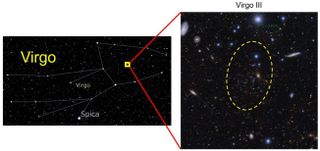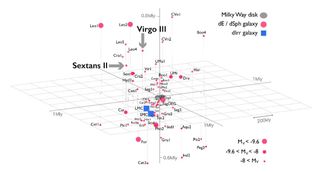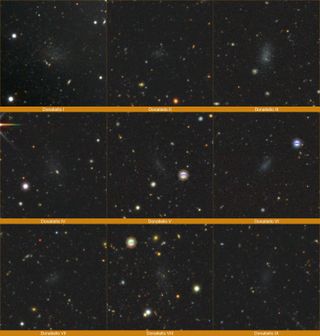Astronomers have discovered two new satellite galaxies of the Milky Way, and the findings could help us better understand dark matter—the mysterious substance that makes up about 85 percent of the matter in the universe yet remains virtually invisible to our eyes.
The findings also bring scientists closer to solving a persistent problem with the Standard Model of cosmology, or the “cold lambda matter model,” also known as the “cold matter model.”L“CDM,” in which the word “cold” implies that dark matter is composed of particles moving slower than the speed of light.
The newly discovered small star clusters have been named Sextans II and Virgo III. They join the roughly 60 known dwarf galaxies orbiting our much larger spiral galaxy at distances of up to 1.4 million light-years. The most famous and largest of these Milky Way satellite dwarf galaxies are the Large Magellanic Cloud (LMC) and the Small Magellanic Cloud (SMC).
“How many satellite galaxies does the Milky Way have? This has been an important question for astronomers for decades,” Masahi Chiba, team leader and professor at Tohoku University, said in a statement.
Related: Amateur Astronomer Discovers Five Fascinating New Galaxies — And They Now Bear His Name
Many of the Milky Way’s dwarf satellite galaxies remain unknown due to their distant and faint nature, but Chiba and his colleagues were determined to start finding these elusive objects. So they turned to the Subaru Telescope. This powerful ground-based telescope, located near the summit of Maunakea, Hawaii, is particularly suited to hunting dwarf galaxies, and the same team had already used it to detect three new Milky Way satellites.

Help! Our dwarf galaxies have disappeared
Dark matter is a persistent cosmological problem because it does not interact with light or the ordinary matter that makes up stars, planets, moons, and ourselves. And if it does interact with these things, those interactions are far too weak for us to notice.
This means that dark matter could be composed of as-yet-unknown particles, although potential explanations do not require particle physics. For example, scientists have explored the idea that dark matter could be made of tiny primordial black holes, leftovers from the Big Bang.
However, dark matter does interact with gravity, which can influence the motion and dynamics of light and ordinary matter. This has allowed scientists to infer the presence of dark matter and determine that large galaxies are surrounded by vast halos of this mysterious substance. These halos, it is thought, extend far beyond galactic disks and halos of visible matter.
THE LThe CDM predicts that these dark matter halos played an important role in the evolution of galaxies. In the early universe, they formed gravitational wells into which the gas and dust that formed stars within galaxies were drawn. Eventually, these halos also came together, forming large galaxies like the Milky Way.

This model also suggests that there should be hundreds of satellite galaxies around the Milky Way and other major galaxies. For example, simulations using LAccording to CDM predictions, our neighboring galaxy, Andromeda, should be surrounded by about 500 satellite galaxies. Yet astronomers have observed only 39 dwarf galaxies swirling around Andromeda.
For the Milky Way, some simulations based on the Standard Model of cosmology indicate that our galaxy should be surrounded by about 220 dwarf galaxies, but scientists cannot determine where they are all. The discovery of Sextans II and Virgo III helps to redress this balance. However, the results arising from these discoveries could present cosmologists with the opposite problem they faced before.

Not enough dwarf galaxies or too many?
Although the number of Milky Way galaxies identified is still far below the expected 220 dwarf galaxies, the team behind the research took into account the fact that Subaru cannot see the entire night sky above Earth.
They combined the distribution of dwarf galaxies that Subaru was able to see with its “footprint” in the night sky to calculate an estimate of the number of satellites should, actually surround our galaxy. This led to the calculation that 500 galaxies surround the Milky Way, more than double the amount predicted by simulations based on the LMDP.
So have scientists moved from a “not enough dwarf galaxy problem” to a “too many dwarf galaxy problem”?

Maybe not. Recently, amateur astronomer Giuseppe Donatiello discovered five new satellite galaxies around the Sculptor Galaxy, officially known as NGC 253.
Studying with a team of astronomers the distribution of satellite galaxies around the Sculptor Galaxy, including three previously discovered by Donatiello himself, he discovered that the distribution of these galaxies, located about 11.5 million light-years from Earth, was uneven. In other words, the tiny galaxies seemed to have a “favored direction,” with more galaxies located on one side of the Sculptor Galaxy than on the other.
If there is also a preferred direction for dwarf galaxies around the Milky Way, and the Suburu telescope is looking in that direction, then the estimates based on Subaru’s observations would be inflated.
The team behind these discoveries about the Milky Way’s dwarf galaxies now intends to study in more detail the actual number of satellite galaxies around us using another ground-based telescope.
“The next step will be to use a more powerful telescope that can capture a wider view of the sky,” Chiba concludes. “Next year, the Vera C. Rubin Observatory in Chile will be used for this purpose. I hope that many new satellite galaxies will be discovered.”
The team’s results were published June 8 in the Publications of the Astronomical Society of Japan.